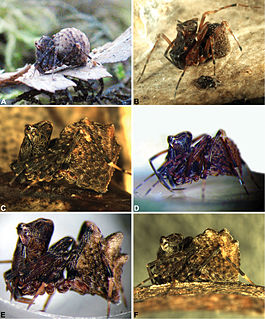
Migidae, also known as tree trapdoor spiders, is a family of spiders with about 100 species in eleven genera. They are small to large spiders with little to no hair and build burrows with a trapdoor. Some species live in tree fern stems. They have a Gondwanan distribution, found almost exclusively on the Southern Hemisphere, occurring in South America, Africa, Madagascar, Australia, New Zealand and New Caledonia.
Idiosoma is a genus of Australian armored trapdoor spiders that was first described by Anton Ausserer in 1871. Originally placed with the Ctenizidae, it was moved to the armored trapdoor spiders in 1985. The name is derived from the Greek ἴδιος (idios), meaning "individual, unique", and σῶμα (soma), meaning "body", referring to the distinctive structure of the abdomen.
Bertmainius tingle, also called the tingle trapdoor spider, is a small basal spider endemic to the tingle and karri forest of southwestern Western Australia. This migid was first recorded in the 1990s.
Blakistonia is a genus of Australian armored trapdoor spiders that was first described by Henry Roughton Hogg in 1902.
Cataxia is a genus of Australian armored trapdoor spiders that was first described by William Joseph Rainbow in 1914.
Euoplos is a genus of Australian armored trapdoor spiders that was first described by William Joseph Rainbow in 1914.

Zephyrarchaea is a genus of Australian assassin spiders first described by Michael Gordon Rix & Mark Harvey in 2012 for nine new species and two that were formerly placed in the genus Austrarchaea. The name is based on the Latin zephyrus, meaning "west wind", referring to the western distribution in Australia and a preference for windy, coastal habitats by some species. It has been encountered in Western Australia, Victoria and South Australia.
Bertmainius colonus is a spider in the family Migidae. It was first described in 2015 by Mark Harvey, Barbara York Main, Michael Rix and Steven Cooper, and is endemic to south-western Australia.
Bertmainius monachus is a spider in the family Migidae. It was first described in 2015 by Mark Harvey, Barbara York Main, Michael Rix and Steven Cooper, and is endemic to south-western Australia.
Bertmainius mysticus is a spider in the family Migidae. It was first described in 2015 by Mark Harvey, Barbara York Main, Michael Rix and Steven Cooper, and is endemic to south-western Australia.
Bertmainius opimus is a spider in the family Migidae. It was first described in 2015 by Mark Harvey, Barbara York Main, Michael Rix and Steven Cooper, and is endemic to south-western Australia.
Bertmainius pandus is a spider in the family Migidae. It was first described in 2015 by Mark Harvey, Barbara York Main, Michael Rix and Steven Cooper, and is endemic to south-western Australia.
Bertmainius tumidus is a spider in the family Migidae. It was first described in 2015 by Mark Harvey, Barbara York Main, Michael Rix and Steven Cooper, and is endemic to south-western Australia.

Barbara Anne York Main was an Australian arachnologist and adjunct professor at the University of Western Australia. The author of four books and over 90 research papers, Main is recognised for her prolific work in establishing taxonomy for arachnids, personally describing 34 species and seven new genera. The BBC and ABC produced a film about her work, Lady of the Spiders, in 1981.
Cataxia colesi is a species of spider native to south-western Australia. The species has an extremely small distribution range, restricted to individual sky islands in the Stirling Range National Park. It digs burrows up to 20 cm deep.

Gaius villosus is a species of spider in the family Idiopidae found in Western Australia in a variety of different habitats.

Gaius is a genus of large mygalomorph spiders in the family Idiopidae. Erected in 1914, for much of its history the genus contained only one species, Gaius villosus. More species were added in 2018. All are endemic to Western Australia.
Eucanippe is a genus of Western Australian armored trapdoor spiders first described by Michael Gordon Rix, Robert J. Raven, Barbara York Main, S. E. Harrison, A. D. Austin, S. J. B. Cooper & Mark Stephen Harvey in 2017.
Bungulla is a genus of Australian armored trapdoor spiders first described by Michael Gordon Rix, Robert J. Raven, Barbara York Main & Mark Stephen Harvey in 2017.



